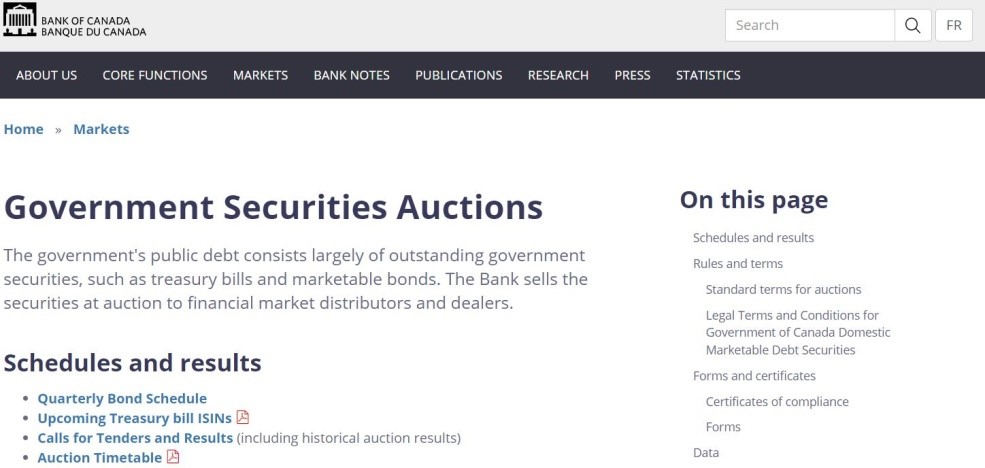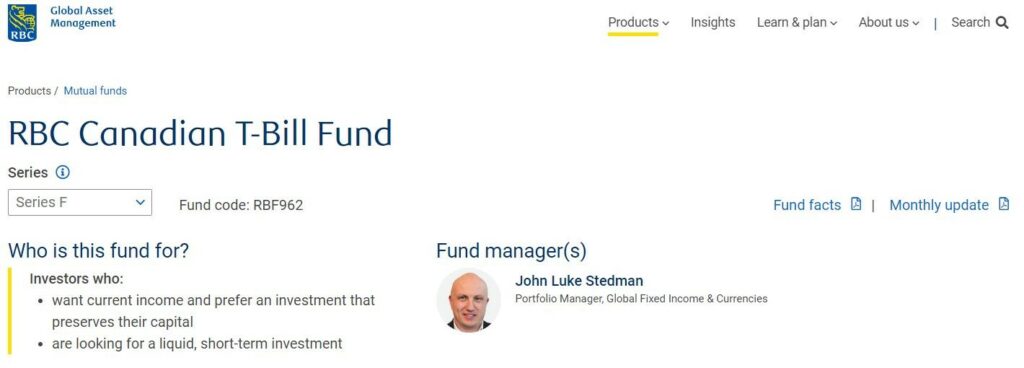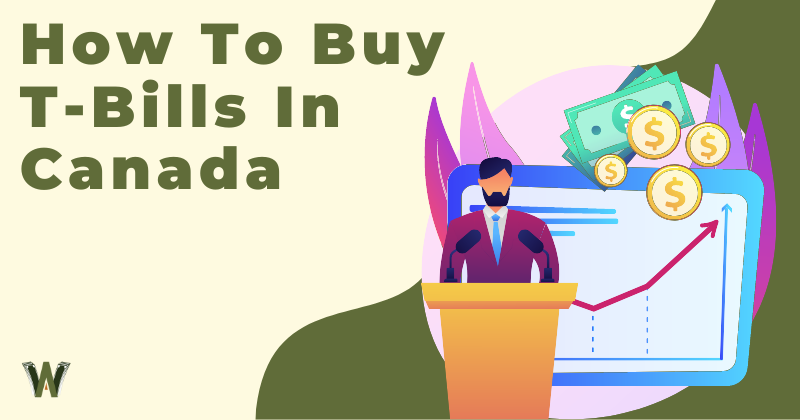Are you looking to invest in T-bills in Canada but aren’t sure how to get started? Buying T-bills in Canada can be a good investment option for those who are looking for a low-risk way to grow their money.
Canadian T-bills have experienced explosive growth in yield recently, mainly in response to rising interest rates and inflation.
Three steps to purchasing T-Bills in Canada:
- Determine what approach you will take to purchasing T-Bills
- Open an account with a financial institution that allows you to purchase T-Bills
- Submit an order to purchase the T-Bills
I will cover how to buy T-bills in Canada below and outline each step in more detail.
When to Consider Investing in T-Bills
T-Bills are issued by governments (the Canadian government here in Canada) and are therefore considered extremely low-risk investments. They can be used to match short investment horizons or for investors with an extremely low-risk tolerance.
One key factor that affects T-Bills is the expectation for interest rates going forward.
If interest rates in Canada rise after a T-Bill have already been purchased, it will become less attractive for investors on the secondary market. If interest rates in Canada fall after a T-Bill has been purchased, it will become more attractive for investors on the secondary market.
How to Buy T-Bills in Canada
Before outlining how to buy T-Bills in Canada, I will assume that you have determined that Canadian T-Bills are a good investment for your particular circumstance.
Step 1: Determine Your Approach to Buying Canadian T-Bills
Although there are three different ways to purchase Canadian T-Bills, only two approaches are recommended for the average investor.
1st approach – Through the primary market
The first approach to buying Canadian T-Bills is through the primary market or directly from the Bank of Canada at their periodic auctions. This approach is not realistic as it is much more complicated and time-consuming than the other two methods.

2nd approach: Buy through the secondary market
The second approach is to buy already-issued Canadian T-Bills through the secondary market. Most brokerage accounts allow you to buy T-Bills through their online platform or over the phone.
3rd approach: Use ETFs or mutual funds
The third approach is to buy T-Bills through a pooled investment such as an exchange-traded fund (ETF) or a mutual fund. This is the simplest approach and offers access to much better diversification than buying individual T-Bills.

T-Bill pooled investments are usually offered with a low management expense ratio, meaning that you will have to pay fees for the management of the fund.
I strongly recommend investing in T-Bills in Canada either directly through your broker (on the secondary market) or through a T-Bill exchange-traded fund.
Step 2: Opening a Brokerage Account
Whether you are choosing to buy T-Bills through a pooled investment or directly on the secondary market, you will need to open a brokerage account with a financial institution that supports the purchasing of T-Bills and other government bonds.
Working with an investment advisor will also allow you to purchase T-Bills in Canada in most cases (the advisor purchases them in your account for you). I don’t recommend this approach since advisors typically charge high advisory fees and T-Bills generally offer conservative returns.
If you are not opening an account with an investment advisor, you will be opening a self-directed account. You will want to pick a discount brokerage based on whether you will be buying T-Bills through a pooled investment or directly on the secondary market.
If you are looking to trade T-Bill mutual funds or ETFs, you will want to focus on discount brokerages that offer commission-free trading. In particular, for T-Bill ETFs, a great option here in Canada is Wealthsimple Trade.
Wealthsimple Trade allows you to trade most North American stocks and ETFs without paying trading commissions. Make sure to take advantage of a bonus when signing up for Wealthsimple Trade.
When planning to trade T-Bills on the secondary market (without funds), make sure to consider Questrade. Questrade offers commission-free bond trading with a minimum order of $5,000. Make sure to take advantage of the free trades when signing up for Questrade.
Opening an account with major discount brokerages in Canada is straightforward and can usually be done online.
Before opening an account, consider the different account types available to you and which makes the most sense in your particular case. Make sure to read my guide on the best investment accounts in Canada to get a sense of some of the accounts that are typically available to Canadians.
Step 3: Submitting an Order to Purchase the T-Bills
Submitting a T-Bill purchase order will differ depending on whether you buy T-Bills through a pooled investment or directly on the secondary market.
Since mutual funds typically come with significantly higher fees than ETFs, I almost always recommend investing through a passive ETF instead of a mutual fund when possible.
Buying a T-Bill ETF
Buying a T-Bill ETF is done in the same way that you would purchase any other ETF or stock. The ETF can be bought using a wide range of orders, although I recommend limit or market orders for most Canadians.
Market orders will immediately purchase the ETF at the best price available when the order is submitted. You will not know your purchase price until after the trade is executed.
Limit orders allow you to specify which price you are buying an ETF at, but not when it will actually be bought. Your ETF units will be bought at some point in the future at your outlined price or better,as long as the ETF’s unit price meets the price that you have inputted in your order.
Orders to buy or sell ETF units can be submitted through most brokerages’ mobile applications, online through a web browser, or over the phone. You will have to research which fund you would like to purchase beforehand, as well as what exchange the fund trades at and what its exact ticker is.
Buying T-Bills (and other Fixed Income) Directly
You can also submit an order to buy a T-Bill directly through most discount brokerages that support it. Remember that some discount brokerages may be limited in the asset classes they allow for trading.
When buying T-Bills and other fixed income directly on the secondary market, you will usually be purchasing these instruments over the phone. Make sure you have researched what type of T-Bill you would like to purchase beforehand.
If you buy fixed income or T-Bills through Questrade, you must call Questrade’s bond desk, seen here:

Once you have submitted your order and it has been filled, you have successfully bought one or more T-Bills in Canada.
Selling and Redeeming T-Bills
After successfully purchasing T-Bills, there might come a time when you want to cash in on your investment.
Selling on the Secondary Market: Just as you can buy T-Bills on the secondary market, you can also sell them here. Brokerages that support the purchase of T-Bills typically also support their sale. The process involves setting a selling price, much like you would with stocks or ETFs, and waiting for a buyer. The price you get might be influenced by prevailing interest rates and the time left to the T-Bill’s maturity.
Redeeming at Maturity: If you hold your T-Bill until its maturity date, it will be automatically redeemed, and the principal amount, along with the accrued interest, will be credited to your account. Remember, T-Bills are discount securities, so the interest you earn is the difference between the purchase price and the face value received at maturity.
Frequently Asked Questions
T-Bills Canada Rates?
T-Bill Rates in Canada are constantly changing over time, and it is important to stay up-to-date on the latest yields across different maturities. Common maturities for Canadian T-Bills include:
- One month
- Three months
- Six months
- One year
You can find the latest yields for different maturities by visiting the Bank of Canada website. The website also outlines T-Bill yields over time, allowing you to see how yields have changed over longer-term periods.
Canadian Treasury Bill Yield Calculation?
T-Bills have two main yields that investors look at when considering their purchase. These are the discount yield and the investment yield.
The discount yield determines how much a T-Bill yields relative to its face value.
The investment yield determines how much a T-Bill yields relative to its purchase price.
Keep in mind that the purchase price of T-Bills and other bonds will fluctuate on the secondary market (after they have been issued and are traded among investors). The main factor causing price shifts for T-Bills on the secondary market is a changing level of interest rates.
Investopedia does a great job of outlining both yields in more detail and how to specifically calculate each.
T-Bills vs GICs?
T-Bills and guaranteed investment certificates (GICs) are commonly compared among investors. They are both low-risk fixed-income investments for conservative investors.
T-Bills are bonds issued by a government that typically have a maturity of up to one year. They are backed by the creditworthiness of the issuing government and are also traded on the secondary market once issued.
GICs are issued by financial institutions and have a wide range of maturities (less than one year as well as over one year).
They are backed by the creditworthiness of the issuing financial institution (which is almost always lower than that of the country’s government). GICs do not trade on a secondary market, although they may be redeemed early in some cases.
Since T-Bills are considered to be even safer investments than GICs, they typically offer a lower return. T-Bills also come with higher liquidity which can be very valuable if you do not want to lock your investment up for a specific period of time.
Both the returns of GICs and T-Bills are closely linked to the level of interest rates in the economy.
Conclusion

Investing in T-Bills in Canada is a great way to earn some form of investment returns while also investing in one of the safest investment vehicles available to Canadians.
Keep in mind that since T-Bills are such a safe investment, they typically offer very conservative levels of return (or yield).
T-Bills can be bought in three ways: at a primary auction (not ideal for most investors), on the secondary market through a broker, or through a pooled investment such as a mutual fund or an ETF.
If you are a newer investor, make sure to read my guide on how to start investing in Canada.


Questrade do not offer Canadian or US T-bills. Very frustrating and a big miss in my mind on Questrade.
You can buy it on the secondary market using Questrade, contact their support and they can walk you through it!